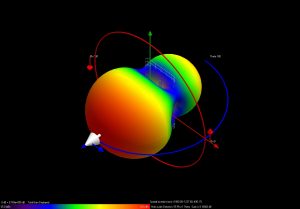Rabbit ears, aluminum foil, coat hangers, or a massive dish taking up half of your backyard. The antenna technology of yesterday included a variety of interesting sights to see, and sometimes, dad may have even asked you to hold onto the antenna and hike up your leg to get better reception. We’ve come a long way from the old days of watching television. Or have we?
A visit to your local big box store will reveal shelves of television antennas with a variety of price points and stunning performance claims. It’s enough to leave even the savviest consumer with questions on what antenna to choose. What if we told you that 90% of the antennas you see are based on the same old technology of using some aluminum foil and a coat hanger? They’re missing out on the latest and greatest, and so are you if you don’t choose wisely.
The Golden Age of Antenna Science
If there ever was a Golden Age of antenna research, advancements, and design, we’re living in it today. Our mobile and technologically advanced communication needs have pushed this research forward, with corporate giants like Apple investing billions of dollars into developing more powerful antennas for their smartphones and tablets; aerospace companies creating better simulators to test performance; and scientists working around the clock to ensure that an antenna the size of a postage stamp, can pack the power of a massive antenna structure.
In the midst of this antenna renaissance, Antennas Direct dusted off old physics books from 2004 and began our mission to build a TV antenna, rooted in radio frequency science, to deliver the best TV antenna performance possible. We had predicted how the digital transition would transform the way people watch television and made the decision to invest millions in research and development, stepping in as the beneficiary of the many technological advances that were taking place (and would continue to take place) during this Golden Age.
No other TV antenna company, not even the largest consumer electronics brands on the planet, followed suit. Antennas are just one of the thousands of product categories they sell, so they’re an afterthought not afforded much attention, and no R&D dollars. Today we remain alone on our path, continuing our research and development to provide the best TV antennas for consumers. It’s in our DNA and will always be the sole focus at Antennas Direct.
Why Antenna R&D Matters
Quite simply, when you purchase a product you expect it to work. We’ve become quite dependent on devices like smartphones, mobile hotspots, fitness trackers, wireless speakers, and yes, your television. These items are among the many products in our lives that leverage antenna technology. For televisions, it’s having a reliable TV antenna performance. To get the best performance from a TV antenna, requires research, testing, and analyzing data to identify where improvements can be made, and to create the best customer experience possible.
Our research has led to many breakthroughs in the science behind antenna technology. We’re in an age of sophisticated simulators and measurement tools that allow us to test and adjust designs before we go into production. Today, we make the most powerful and reliable antennas in the market with the highest success rates for receiving all the available TV channels provided by the major networks. We have the data to prove it and have earned several awards for our innovation.
What’s the Frequency, Richard?
You may be wondering what exactly we’re researching and testing. The answer to that question, without getting too nerdy, has to do with frequencies!
All broadcast signals travel over a specified range of frequencies on the spectrum of available airwaves. While this does include your television signal, it also includes radio, cell phones, air traffic control, police/fire/ambulance communication, the poltergeist living in Carol Ann’s closet, and more. Reliable reception requires the TV antenna element to pick up the right frequencies – and nothing more. (Ultimately, you could argue it was a bad antenna that let the poltergeist into the Freeling house, but we digress.)
The antenna technology of 60 years ago, which every other antenna manufacturer is using, like the rabbit ears, simply does not allow for specific tuning to target the frequencies on which high definition, over-the-air programming is being broadcast today. This old technology casts a wide net, hoping to pick up whatever signal it can and deliver it to your TV. This means there could be a lot of interference to impact the signal strength, performance and ultimately, the number of TV channels you receive in your market. Sometimes if you are within a couple miles of the towers, these traditional antennas will receive enough channels to satisfy a user, but oftentimes they don’t.
In addition, as manufacturers pull this old technology “off the shelf” and package an antenna into their brand, we’ve found that these antennas are not only lacking the ability to target today’s HD antenna frequencies, they’re also not even tuned for United States and Canadian broadcast frequencies. You heard us right, folks.
We don’t believe that hope, luck and a shotgun approach are good strategies when selling consumer goods. That’s why we’ve invested so many resources in research and development. This has allowed Antennas Direct to design TV antennas that receive a very narrow range of frequencies – those on which high definition signals are broadcast – to maximize reliability and performance.
Talk Nerdy to Me, Richard
By this point you may be wondering what tests were doing. Here are just a few things that are happening in our labs:
- We use 3D print technology for rapid prototyping on site.
- Our thoughtful designs minimize wind loading and are tested in environments to withstand 70mph winds and offer UV stable plastics for longevity.
- Materials used in construction are simulated for conductive efficiency and potential RF interference.
- Elements are tuned to only radiate in the bands broadcasters employ post digital transition.
- Using computer modeling techniques, we are able to generate a visual representation of an antenna’s performance as illustrated in the polar plot below.
Customer-First Approach to Antenna Design
The first question we ask ourselves is what will make the product successful for the consumer? Ultimately, we spend the R&D resources for you. We want our customers to have a great experience with an Antennas Direct TV antenna and share their experience with their friends. We want you to have the power to cut the cord with confidence, save money and be liberated from paying a monthly fee to the cable companies.
It’s the consumers need to cut back on their monthly expenditures that keeps us focused on manufacturing the best TV antennas. There’s a purity in that thought process, and it’s indicative of the passion we have for high-quality TV antennas. It’s all we do, it shows in the success rate our customers have when using our products, and it’s all made possible because we care enough to continue to invest in antenna advancements for our customers.

